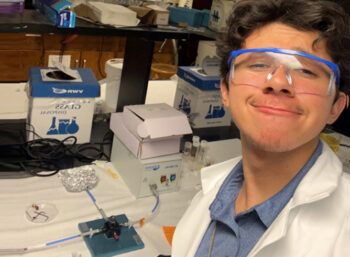How Tiny Crystals Are Giving Solar Panels A Glow-Up

As the global conversation around renewable energy continues to heat up, Juan Guio ‘26 is looking at ways to keep things cool, at least where solar panels are concerned.
Guio spent the spring 2023 semester working on research pertaining to efficiency in photovoltaics as a member of Dr. Matthew Sheldon’s laboratory in the Department of Chemistry at Texas A&M University. While Guio’s part of the project was small — measuring and mapping how different solutions impacted the absorbance of certain wavelengths of light — the work thrilled him.
“The way I see it, small things are what make up the big things, so that makes chemistry very exciting,” he said.

The small things he was working with are a type of tiny crystals known as halide perovskite nanocrystals. “Think of them as little light boosters,” Sheldon said. Students worked on synthesizing these crystals and embedding them into thin, film-like structures to make them suitable for coating solar panels.
“Solar panels, which many of us see on rooftops or large solar farms, convert sunlight into electricity,” Sheldon explained. “One way to make these solar panels even more efficient is to use special coatings that can capture more light. In this research project, undergraduate students explored the development of coatings that can glow under light, essentially amplifying the amount of sunlight that reaches the solar panel.”
This work was very interesting to Guio, who was eager to try new solutions in the lab. “I got excited about figuring out what we could do next,” he said. “One of the properties of these nanocrystals is that when you shine a light at them at a certain energy, they emit light at a higher energy. They do that by taking in some heat.” Absorbing heat as well as light to create energy via a solar panel would be especially useful because it provides cooling as well as light, he explained.
Guio, who is originally from Bogota, Columbia, and currently resides in Houston, says he has long been attracted to chemical engineering because he loves working with chemical reactions. In addition to the science and hands-on lab work for the nanocrystals project, Guio and the other students in the Sheldon Research Group also had opportunities to analyze their results and share them through presentations, practicing the essential work of science communication.
Guio made up solutions of nanocrystals and solvents and then used a spectrophotometer to analyze how changes affected which wavelengths of light were absorbed. He also graphed results of different solutions to create an absorbance map. By the end of the semester, he was able to present the range of results to others in the lab working on different elements of nanocrystal research. He appreciated hearing about others’ research findings, as he built on their work to create a presentation that would provide value to the whole group.
Learning Through Research
While the work he was doing was minor in the larger field of photovoltaic research, Guio says it was a great introduction to the process of investigative lab work.
“I learned that research is not a linear process,” he reflected. “You work on ideas all over the place that open up room for creativity and lead you where you want to go next. You can take a risk and see ‘will this bear fruit and be helpful or not?’ and try other options.”
The experience cemented Guio’s desire to pursue a career in chemical engineering with an emphasis on energy.
“I’m fascinated by energy, in finding ways to improve the oil and gas industry, as well as renewable energy, maybe create something new that hasn’t been thought of yet,” he said.
A key takeaway from the experience for Guio was the importance of reaching out to faculty members to explore collaboration. Sheldon, one of Guio’s favorite teachers, had mentioned his research on photovoltaics in class, and Guio’s curiosity was piqued. He sent Sheldon an email asking if he could be involved in some way and was invited to participate in the lab work, though he was a freshman at the time.
“Don’t be afraid to reach out to a teacher if the topic is interesting to you,” he admonished other students. “Let them know that you’re interested and that you want to work with them, because they love working with motivated students.”
Media contact: Shana K. Hutchins, shutchins@tamu.edu





